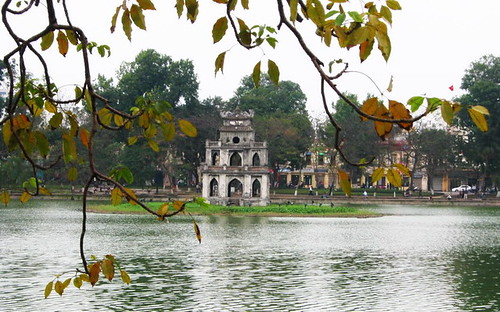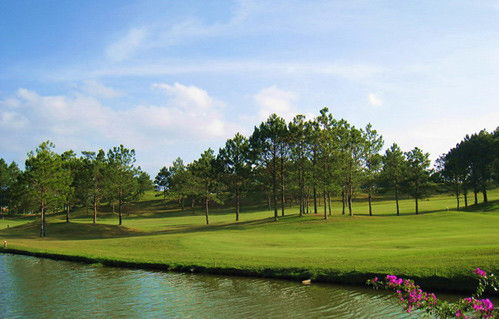1. Take a tour around the legendary Halong Bay
Paddle around Halong Bay in Quang Ninh which is similar to the islands found along the , this is one of Vietnam’s most beautiful areas, Halong Bay has fascinating limestone formations, coves for night-time excursions, sheer cliffs, grottoes, arches and scores of small islets. There are plenty of activities such as kayaking that are well worth taking time out for as this is one way to really appreciate the beauty of the area as well as a good way to see the fauna and flora without disturbing the nature around one.
Visit Hoian. From the 16th to 18th centuries, Hoian was a thriving international commercial port for Chinese, Dutch, French, Japanese, Portuguese and Arab traders. These people came to trade primarily for the high-grade silk, which is still produced in the area, and ceramics. The area is now one of four world heritage listed sites in Vietnam and there are lots of interesting things to see and do in the area.
3. Visit Hanoi for an insight of Vietnamese’s past and present
Hanoi has lots to offer the tourist but if you are in the city you can’t afford to miss the History Museum that includes artifacts from Vietnam’s prehistory: proto-Vietnamese civilisations (1st and 2nd millennia BC), the Dong Son civilisation (7th century BC to 3rd century AD), the Oc-Eo (Funan) culture of the Mekong Delta (1st to 6th century AD); the Indianised kingdom of Champa (1st to 15th century), the Khmer kingdoms, various Vietnamese dynasties and their resistance to Chinese attempts at domination, the struggle against the French, and the history of the Communist Party. It gives the visitor an excellent understanding of Vietnam’s past and a better understanding of the present.
This large market is close to the backpacker area of Pham Ngu Lao in Ho Chi Minh city. The market was formally established by the French colonial powers after taking over the Gia Dinh citadel in 1859. This market was destroyed by fire in 1870 and rebuilt to become Saigon’s largest market. In 1912 the market was moved to a new building and called the New Ben Thanh Market to distinguish over its predecessor.
Hue is one of the most popular destinations for visitors to Vietnam. Straddling the Perfume River, this mysterious, somber city is a historian’s dream come true, with numerous 19th century ruins, royal tombs and an excellent museum.
A perfect Sapa tour will give you a fun experience with combination of trek and journeys away from the crowds. More interesting if you have time with staying at traditional Dao home with local people. Learn and participate in village life and truly feel the warmth and hospitality of these incredible people, or visit the most colorful tribal market in Sapa.
Dalat is the place to be if you want to visit interesting tribal villages. Although most are located further out of town, you can visit the villages of some of the hill tribes, such as Lat Village and the Chicken Village (with a huge statue of a chicken) close to Dalat itself. Don’t forget your camera as the photo opportunities are endless!
Nha Trang is Vietnam’s beach resort town. A major face-lift in 1995-96, and the opening of two upscale hotels later in 1996, vaulted Nha Trang onto the playing field with places like Phuket, Thailand, and Cancun, Mexico. Today, it’s a popular destination for both foreign and domestic tourists. In addition to sun bathing, popular attractions include boat trips to the nearby islands and tours of Nha Trang’s historic sites. If you like typical beach resort towns, then Nha Trang is for you.
Meander along the Mekong on one of the many boat trips that are available taking you across the water or through the local canals on many interesting sightseeing excursions that definitely require a camera. Larger boats venture up the Mekong River and this is a definite MUST DO if you are in the area of Cantho or one of the other cities or villages that rely on this massive sourse of water for both transport and food. Climb Sam Mountain near Chau Doc if you want to see dozens of temples, pagodas and the like as it is well worth visiting. Located about 6 km from the city, temples abound and the trek to the top of the mountain is also popular…though one can go by motorised vehicle if you so desire.
Crawl through the Cu Chi Tunnels This extensive network of nearly 500 km of Viet Cong tunnels used in the French Indochina and American wars. The tunnels have complete facilities, from kitchens to printing presses and even street signs, all of which were used to aid the NLF (National Liberation Front) military. Tours involve a description of the tunnels, after which tourists are allowed to crawl about the maze. Located in Tay Ninh a suburb it is 39km northwest of central Ho Chi Minh City.






















